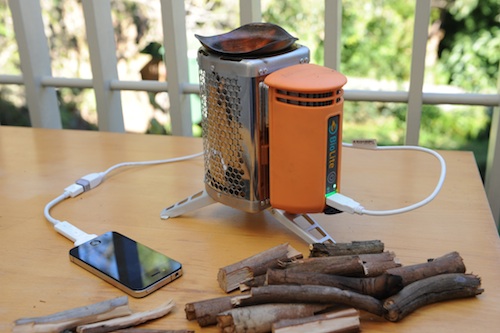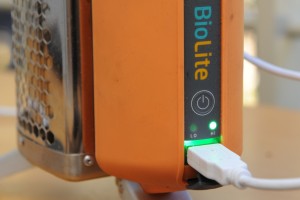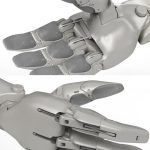The Biolite Stove caused quite a stir when it was first prototyped back in 2010 and so it should. How many devices can tie together a wood-burning stove with a fan and a USB port? Well the good news is, Biolite have gone into production and are now shipping the stoves. Mine arrived last week and so I’ve been camping out on my deck putting the stove through its paces. Click through for a detailed hands-on video showing it in action after the jump.
Out of the box
It’s a robust looking unit, made from aluminium stainless steel and a few trusty pop-rivets, while the power and fan unit is housed in a tough orange plastic. The stove weighs almost a kilogram (990g) and is the size of a Nalgene water bottle. The firebox is surrounded by mesh to keep elbows and stray USB cables from getting burnt. After seeing numerous sparks and embers land on the orange plastic and not leave any holes, I’m fairly confident it’s heat resistant. The three fold-out legs do a great job keeping the stove stable especially with a pot on top and they keep the heat away from whatever surface the stove is on.
Ironically for a USB charging stove, it needs to be charged (via USB) before use. This powers up the internal battery which runs the fan and assists with lighting the stove. Biolite suggest it should only need recharging if the stove isn’t used for 6 months as the thermoelectric unit will recharge the battery during normal use. A double ended USB cable, some wax-based fire-starters and a bag are all included with the stove, so you’re pretty much all set to go after a quick firewood hunt. There’s a power switch for the fan which also toggles between the low and high setting, there’s a USB port behind a rubber cover and a couple of operation lights indicating when there’s enough power to charge. All very simple to use.
In Use
I’ve been trying my stove for a week, using small twigs and wood I’ve gathered from the local bush, mainly eucalyptus. It’s winter here in Sydney and we had just had a week of rain three days before so the first lot of wood I collected wasn’t as dry as it could have been. Initial results weren’t great and the stove regularly went out, accompanied by plumes of fan-forced smoke. I dried the wood in an oven for 20 minutes and got much, much better results. This is the only flaw of the Biolite Stove, it really needs dry wood to work at its best. Wood that was still a little damp could be used but they had to be pretty thin pieces and the fire needed an eye kept on it. A week later, when the ground and wood had dried out I went out foraging again and had much more success. The fire burnt for much longer and was a lot hotter, and I could burn sticks up to 25mm (1″) in diameter. Small sticks do work well but they burn very quickly and you may want to use larger pieces of wood especially while you’re cooking/boiling water.
The Biolite, like all camping stoves makes a little bit of noise. Namely a high-pitched, but not very loud whine from the fan. The best comparison I can make is that it sounds like a hair dryer or vacuum cleaner in a distant room. It’s not loud but it’s ever-present and you don’t notice it after a while. You can’t turn the fan off while the stove is running as it will switch back on automatically to keep the electronics cool.
The whole point of the Biolite Stove is its ability to turn heat from the fire into power for USB charging, so I probably should mention it. I managed to charge the battery on my iPhone 4 from 72% to 84% in 1 hour (your mileage may vary) with a couple of minor interruptions due to insufficient heat. Not fantastic but will definitely get you out of a tight/lonely spot. You have to keep the fire running hot in order to charge with the stove otherwise there isn’t enough power.
Continue Reading… 1 2 [View All]






Becoming a tech savvy hermit just got a little bit easier.
Easy way to rustle up a byte to eat? :)
Two things:
It's made of stainless steel – not aluminium; an important fact/distinction.
Second, I would not burn mine in an enclosed space without ventilation directly from the stove to outside. It will produce CO – carbon monoxide; which is not good for humans!
actualy it would produce almost no carbon monoxide, the whole point is it burns more efficiently and would produce mainly CO2, carbon dioxide while not good in high concentration would unlikely be a problem unless in an airtight room, even most tents have enough ventilation
As a combustion engineer, I’d strongly advise against running this stove in any confined space, especially a tent. You can’t see or smell carbon monoxide, so unless you take a CO detector/alarm with you, you’re only guessing.
As for ventilation, carbon monoxide bonds to the haemoglobin in your red blood cells some 200 times more strongly than oxygen, and it’s cumulative, and takes a long time to leave. Even small amounts of carbon monoxide in the air pose a serious danger.
Danger levels for CO in air for healthy people start at anywhere above fifty parts per million.
So, people, please, please, don’t think that this, or any other non-flued cookstove is safe in a tent or small cabin.
Stay safe, stay alive.
Thanks, I had thought of running it in the open porch of my tent to keep the winter chills off. Nice warning though!
Even if the porch is open, there’s significant risk if you are in the tent. Out in the open is fine, but not where you intend to sleep, and leaving it burning for an extended period increases the risk. Low concentrations make you drowsy. Then you fall asleep and don’t wake up. But you make a nice healthy looking, pink skinned corpse, because your red blood cells are full of carboxyhaemoglobin.
“Cases 1-4. On the afternoon of March 14, 1999, a 51-year-old man,
his 10-year-old son, a 9-year-old boy, and a 7-year-old girl were found
dead inside a zipped-up, 10-foot by 14-foot, two-room tent at their
campsite in southeast Georgia (a pet dog also died). A propane gas
stove, still burning, was found inside the tent; the stove apparently
had been brought inside to provide warmth. The occupants had died during
the night. Postmortem carboxyhemoglobin (COHb) levels measured 50%,
63%, 69%, and 63%, respectively, in the four decedents (in the general
U.S. population, COHb concentrations average 1% in nonsmokers and 4% in
smokers [3]).”
Even if the porch is open, there’s significant risk if you are in the tent. Out in the open is fine, but not where you intend to sleep, and leaving it burning for an extended period increases the risk. Low concentrations make you drowsy. Then you fall asleep and don’t wake up. But you make a nice healthy looking, pink skinned corpse, because your red blood cells are full of carboxyhaemoglobin.
“Cases 1-4. On the afternoon of March 14, 1999, a 51-year-old man,
his 10-year-old son, a 9-year-old boy, and a 7-year-old girl were found
dead inside a zipped-up, 10-foot by 14-foot, two-room tent at their
campsite in southeast Georgia (a pet dog also died). A propane gas
stove, still burning, was found inside the tent; the stove apparently
had been brought inside to provide warmth. The occupants had died during
the night. Postmortem carboxyhemoglobin (COHb) levels measured 50%,
63%, 69%, and 63%, respectively, in the four decedents (in the general
U.S. population, COHb concentrations average 1% in nonsmokers and 4% in
smokers [3]).”
I got one of these for hiking, alas, its a bit too heavy though. Best part about it is you can take it on a plane, no issues with fuel or fuel containers, and not worry about finding a gas cartridge or alcohol at the other end of your flight. Couple it with a $2 ebay USB snake light and you can cook in the dark a lot easier! It will certainly spend a lot of time on my motorcycle tours.
My husband got this stove…I wish I could get our $ back on this one. We do camp and hike…and have a msr pocket rocket (great). Compared to using pocket rocket…the biolite is a major pain in the butt! You have to find dry wood…hard in a temperate rain forest like I live in (base of Appalachian Mountains). The biolite's heavy! The fire control is a total pain! As for recharging ability…it's painfully slow! You'd have to keep a fire going for hours to charge anything…completely impractical! I went camping last weekend…happily took my pocket rocket and a battery powered phone recharger…much happier with that setup.
"I managed to charge the battery on my iPhone 4 from 72% to 84% in 1 hour"
What was the ambient temperature while you were charging?
Would this be appropriate on a 2+ month canoe trip into remote Canada? I’ll probably also have a small solar panel, but this seems like a good duel purpose piece of gear. I don’t know what electronics I’ll be taking with me but it will include GPS, some sort of communication device (sat phone?) camera, and maybe an e-reader or tablet.
What do you think?
Amazon Kindle ereaders run 2 months on a charge.
After 4-5 months of use – is it still recharging as well as it did out-of-the box? Will the stove still charge items even after the battery wears out provided it's burning something?
Does anyone know of any Biolite Campstove reviews where the reviewer's used it over a period of months?? Just so we can have an idea of how it operates in the longer term and whether the battery that operates the fan degrades significantly (as batteries do when exposed to heat). It's a great concept and it's for a fantastic cause, but I'm quite concerned about the battery as it isn't easily replaceable as it's reportedly taped in/ soldered, I'm not tech savvy and so really have no idea what happens if the battery dies and the fan no longer works. So far no one has comments on this or other review sites…
Mm…that's a very good point Abbi. Maybe Dan can come back with a mini report here if he's still using it?
After running the Biolite for 6 months now (nearly) I can say that all is still well. The firebox is double-walled with fan-forced air circulating between the walls. The thermoelectric generator probe (copper bit in the flames) has thick insulating where it exits the orange box and the air drawn in by the fan seems to circulate inside the orange part before going into the firebox. As a final precaution if you turn off the stove when it's too hot the fan will turn back on to cool the thermoelectric unit.
So as far as I can tell the battery is very safe inside its case and all care has been taken to minimise its exposure to heat. The Biolite FAQs – http://www.biolitestove.com/faq/faqs/ claim it's easily repair and to contact them for more information.
Went to the cool tech section of this site and stumbled upon this. After reading the article, to my surprise, it’s over a year ago. But that couldn’t keep me from saying this, I think. I guess the flaw is understandable. On a regular charcoal stove, you can’t make a spark if the twigs or charcoals you are using aren’t all dried up. A stove that could also charge and do stuff? Well, it still amuses me.